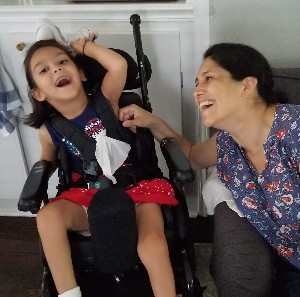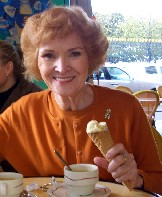Why do Uber and Lyft think they don’t have to pick up passengers with disabilities?
by Beth Finke
 Back in 2014 the Chicago Tribune published an op-ed piece I wrote that was titled “Should ride-sharing services adhere to the Americans with Disabilities Act?” Five years have passed, and Lyft and Uber still claim they don’t have to follow ADA guidelines.
Back in 2014 the Chicago Tribune published an op-ed piece I wrote that was titled “Should ride-sharing services adhere to the Americans with Disabilities Act?” Five years have passed, and Lyft and Uber still claim they don’t have to follow ADA guidelines.
A story in Politico last week reports that Lyft is fighting a federal class action lawsuit filed in New York’s Westchester County on the grounds that “it is not in the transportation business.”
Ahead of its public offering, Lyft acknowledged it has been involved in legal battles about its ongoing refusal to comply with the Americans with Disabilities Act. From The Politico story :
“For a company that says they want to do the right thing — they should do the right thing,” said attorney Jeremiah Lee Frei-Pearson, who is representing the plaintiffs in the New York class action lawsuit. “Not serving people with disabilities is very inconsistent with the public message that Lyft wants to send as being an inclusive and progressive company.”
Suits have been filed against Uber, too, and Uber also maintains that its drivers do not have to follow the Americans with Disabilities Act (ADA). Attorney Frei-Pearson told Politico that he and his colleagues have been reluctant to sue Uber at the same time they bring up this case against Lyft because of all the other other national litigation against Uber.
The Politico story says, “Lyft continues to bill itself as a better-behaved version of arch-rival Uber,” and Campbell Matthews, a spokesperson for Lyft, wrote in an emailed statement to Politico that “We think about accessibility broadly and know that many who were previously underserved by transit and taxis are now able to rely on Lyft for convenient and affordable rides.”
So does that mean it’s okay to refuse riders with disabilities? The ADA says “public transportation authorities may not discriminate against people with disabilities in the provision of their services,” but Uber and Lyft identify themselves as technology companies — not transportation companies. The drivers are independent, they drive their own vehicles, so Uber and Lyft feel they are not required to provide ADA-mandated vehicles and rides.
I try to avoid using ridesharing companies on principle and have only taken about a dozen rides on Uber and Lyft over the years. Only one driver refused to take me with my service dog, and that was a Lyft driver. Without the law on my side, my only recourse was to call another driver and hope they’d take me. It all makes me feel unworthy.
Whenever possible, I ride in a registered cab rather than using a ridesharing service. Cabs that are registered are part of a public transportation authority, registered cab drivers go through a lot of training to get their cab licenses, they are professional drivers, they know where they’re going, and when I call for a ride, I have the law on my side: the ADA prohibits public transit authorities from discriminating against people with disabilities in the provision of their services. And then there’s this: I tip well!
Now, that doesn’t guarantee that registered cab drivers will pick me up with my Seeing Eye dog, but it does guarantee I have recourse. When we moved to Chicago in 2003 I filed formal complaints with the City of Chicago after two separate cab drivers refused to take me with my Seeing Eye dog. Both drivers had their license revoked for a month, and both were fined. I haven’t been refused a ride from a registered cab for years. I think that’s because they know the law.
I get the utility of Uber and Lyft. Especially outside of major cities and downtowns. But, by all accounts, they cut every corner they can. So whenever possible, I’ll cut them out, too.


















 While Easterseals now serves 1.5 million people in 70 affiliates across the country, our story started as the vision of one grieving father in Elyria, Ohio. After losing his son in a tragic accident, our founder, Edgar Allen, was determined to make a difference for children just like his son, so he set out to do everything he could to change the course of history for generations to come.
While Easterseals now serves 1.5 million people in 70 affiliates across the country, our story started as the vision of one grieving father in Elyria, Ohio. After losing his son in a tragic accident, our founder, Edgar Allen, was determined to make a difference for children just like his son, so he set out to do everything he could to change the course of history for generations to come. The dramatic increase in polio cases during the early 20th century caused the disease to be regarded as an epidemic. Thousands of children and adults became paralyzed by polio, and Easterseals founder Edgar Allen raised funds and built a hospital where children with polio could be fitted with crutches and leg braces. Many children remained at that hospital afterwards to attend school there, but what event motivated this successful businessman to sell his businesses and devote himself to providing help for people with disabilities?
The dramatic increase in polio cases during the early 20th century caused the disease to be regarded as an epidemic. Thousands of children and adults became paralyzed by polio, and Easterseals founder Edgar Allen raised funds and built a hospital where children with polio could be fitted with crutches and leg braces. Many children remained at that hospital afterwards to attend school there, but what event motivated this successful businessman to sell his businesses and devote himself to providing help for people with disabilities? I was up at 6 a.m. the day we’d be heading to the hotel. I’d gone to sleep early the night before and was too excited to sleep anymore. I used VoiceOver, the speech synthesizer app on my iPhone, to text Joe shortly upon waking up in the morning, as per usual. “The day has finally arrived!” I texted, followed by a countdown until he would arrive at my house.
I was up at 6 a.m. the day we’d be heading to the hotel. I’d gone to sleep early the night before and was too excited to sleep anymore. I used VoiceOver, the speech synthesizer app on my iPhone, to text Joe shortly upon waking up in the morning, as per usual. “The day has finally arrived!” I texted, followed by a countdown until he would arrive at my house.